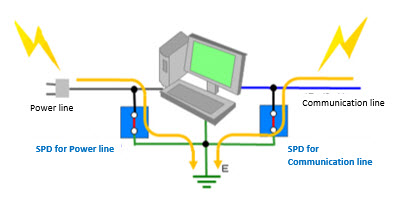Basic approach to lightning protection
The purpose of lightning protection is broadly divided into "protecting buildings and people" and "protecting equipment in buildings". Introducing the classification of lightning protection systems and the concept of lightning protection using lightning protection products such as SPD.
Lightning protection system
External lightning protection system
The purpose is to prevent building damage and fire due to lightning strikes (direct lightning strikes). It is composed of three parts, a "lightning receiver system" including a lightning rod, a "down conductor system", and a "grounding system". This system allows lightning current to flow smoothly to the ground by receiving lightning from the lightning rod instead of the building. Since it is not possible to prevent lightning strikes, the idea is to create a path for lightning (electric current) in advance and have it pass through it to reduce damage to buildings and people. The damage caused by lightning is not only direct lightning, but also backflow lightning and guided lightning. Therefore, please note that an external lightning protection system for direct lightning is not sufficient as a lightning countermeasure.
Internal lightning protection system
When a building has a lightning strike and a lightning current flows through the external lightning protection system to the ground, the potential of the ground rises, creating a potential difference with the surroundings. Therefore, it is a protection system based on "equipotential bonding" that uses a common ground to prevent potential differences. Prevents the potential difference from entering the building as a back lightning.
Lightning protection system for electrical equipment and installations
This system aims to reduce damage caused by guided lightning. When a lightning strike occurs, a huge electromagnetic field is generated. This electromagnetic field causes a lightning surge (induced lightning) on the metal line. Most of the lightning damage is believed to be due to this guided lightning. Since it is difficult to prevent the occurrence of guided lightning, this system is based on the idea of "do not let generated guided lightning intrude."
Lightning protection system using SPD
This is a method to protect equipment and facilities using SPD. When the guided lightning enters the SPD, it receives it to the ground and prevents it from entering the equipment. It is closely related to the internal lightning protection system in that the equipment and SPD have a common ground.
Equipotential bonding method (common grounding method)
If the grounds are separate, a potential difference will occur between any other ground when the ground potential rises. This potential difference penetrates the device through the cable. If the potential difference exceeds the withstand voltage of the device, the device will be broken due to breakdown. Therefore, equipotential bonding is based on the principle of "common grounding to eliminate potential difference".
Install the SPD between the cable connected to the equipment you want to protect and the ground wire, and make the equipment and the SPD grounded in common. Grounding is common through SPD, so there is no potential difference between the power line and communication line, and the equipment can be protected.

Bypass method
The equipotential bonding method cannot be used without a ground wire. Therefore, there is a bypass method that "releases lightning surge to another cable without passing through the ground".
Connect the power line and communication line of the device you want to protect via SPD. When a lightning surge enters from one cable, the SPD operates and the lightning surge does not pass through the equipment, but flows to the other SPD. Therefore, the equipment does not have to be affected by the surge. This method is used in general households where it is difficult to ground.

